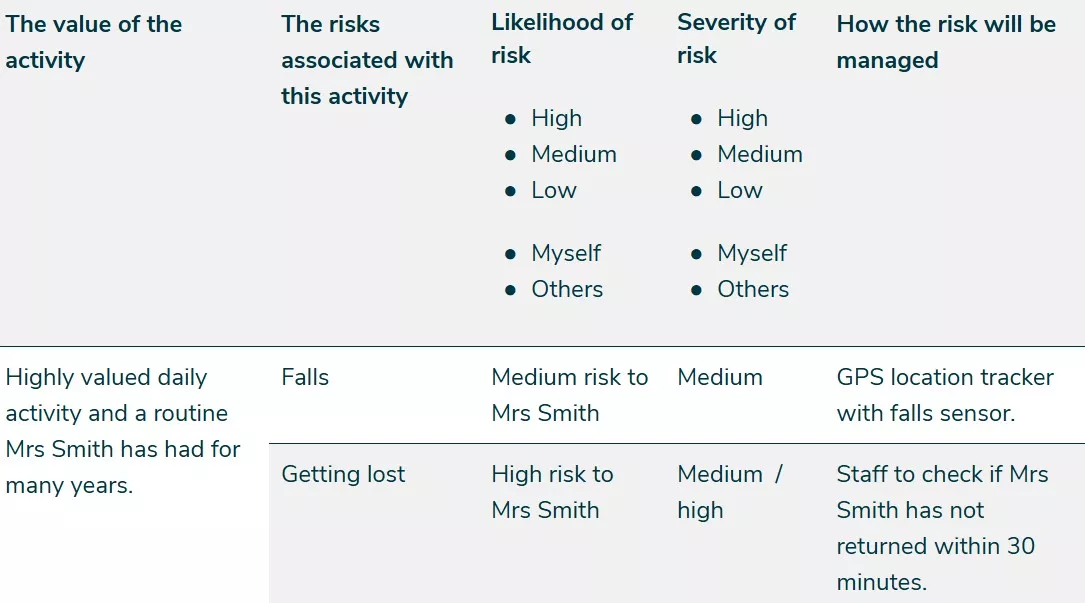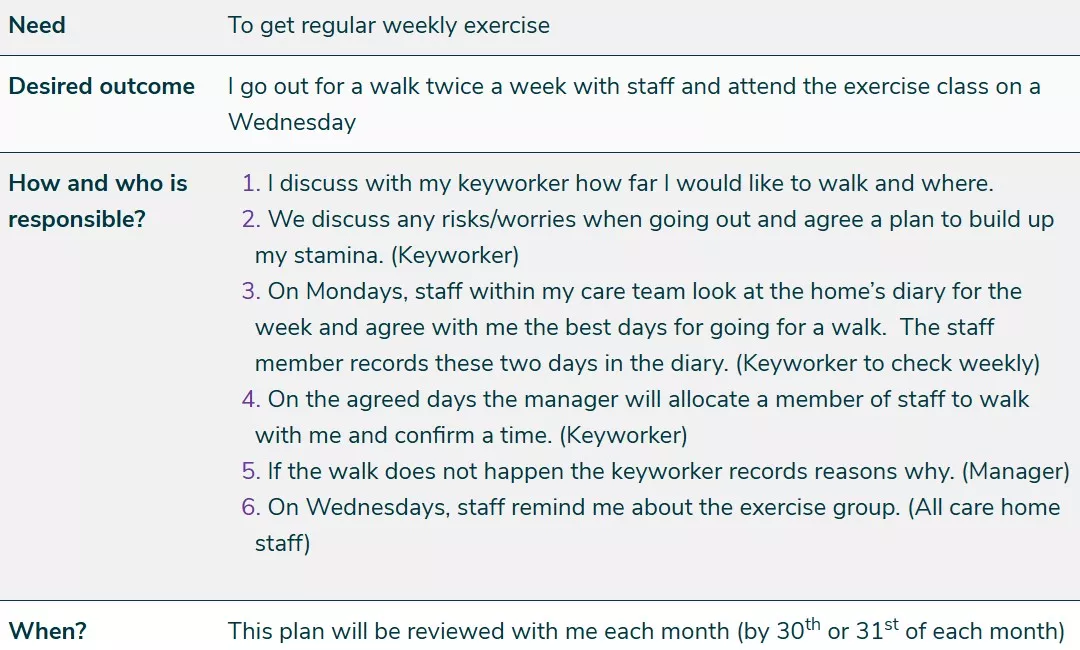Living well in care homes
01 January, 2023
(424 KB)
7+ minute read
Keeping active is essential to living a fulfilling life. That applies to everyone, especially older people living in care homes.
This resource is for residents, members of staff and care home managers. It offers best practice in supporting older people to enjoy daily activities that support their health and wellbeing.
Sometimes it's best practice to consult an occupational therapist. When that's the case, it’s flagged up in a green box.
Residents
Moving into a care home is a major life event. The move may be long-considered, or have happened quickly, following an illness or accident. Whatever the circumstances, it is likely to be a major upheaval that often feels like a loss or bereavement.
However, the security of having extra support and care can be reassuring during this time of change.
As a resident, or family member or friend, there are many ways you can make sure the care received in the new home is right. You can influence that care, so that you, or they, can enjoy an active and purposeful life.
Doing the things you enjoy
When living in your own home, you may have spent so much energy managing day-to-day life, that you were less able to do the activities you enjoy. When you move into a home, you’ll have staff to support you, so you can do more of the things you enjoy.
Being part of your new community
Before you moved into the care home, you may have enjoyed organising events, running a singing group, or editing a newsletter. Why not carry on doing those things in your new home? Small tasks matter too – like looking after the houseplants or getting some exercise by delivering the post to your fellow residents.
Making sure staff get to know you
- Let staff know your likes and dislikes, interests, and who and what is important to you.
- Tell staff what everyday skills and activities you can and cannot do and what you might like to practise.
- Talk to staff about your culture and previous lifestyle.
- Discuss your spiritual needs and how these can best be met.
- Talk about the activities and roles that you want to keep up.
- Discuss how you like to have your routine.
- Discuss ways to keep mentally stimulated and physically active.
Moving into a care home
Family and friends
In a good care home:
- There is a warm and welcoming atmosphere
- Your relative/friend feels safe and speaks fondly of staff and other residents
- Your relative/friend has opportunities to do activities and have responsibilities around the home e.g. caring for plants or pets
- The home has activity coordinators, it welcomes volunteers and organises trips and events
- Your relative/friend has been asked about their cultural and spiritual needs and the home is actively helping to meet them.
If your friend or relative can’t tell you how they are feeling, you can look for signs of wellbeing, such as:
- A relaxed posture
- Ability to express emotions
- Humour
- Pleasure
- Connections with other people.
Supporting your friend or relative
Care home staff
Activity and why it's important
Helping residents to be active in their daily life is an essential part of good care.
When a person is left to sit for most of the day with little movement or stimulation their physical and emotional wellbeing can suffer. They may experience muscle wasting, poor sleep patterns, loss of appetite, confusion, low mood and poor concentration.
It’s important that you encourage and support people to actively participate in daily life. This resource explains how.
Some people may have a range of health needs and it may be hard to know how best to support them. Ask the GP or local authority to refer you to an occupational therapist. They will be able to offer an assessment and will know how best to help.
Activity doesn’t necessarily mean exercise – it means anything that we do – but most activity involves physical movement. Many people will not be able to take part in what we normally think of as ‘exercise’ but there many different activities that use different muscles and joints in the body. For example, singing exercises the diaphragm, and standing up uses balance and uses our bottom and leg muscles.
Regular activity improves health
- General fitness levels
- Muscle strength and joint mobility
- Balance, posture and coordination.
- Bone density
- Skin integrity
- Appetite
- Sleep pattern and quality
- Blood pressure and the potential for thrombosis and embolism diminishes
- Urinary continence
- Blood circulation and breathing patterns
- Immune system.
Regular activity improves wellbeing
- Sense of belonging and purpose
- Self-esteem and self-worth
- Social connectedness- friendships
- Empowerment – a sense of choice, dignity and control
- Maintaining old roles and learning skills
- Confidence in abilities
- Alertness to environmental stimuli increases
- Concentration and memory
- Outlet for emotions and self-expression
- Relieve stress and feelings of boredom and agitation
- Daily living function.
Getting active
Motivation
How can I motivate people to take part in activities?

Communication
Communication is the way that we express our thoughts, feelings, hopes, fears and aspirations. It’s the way that we show others who we are as an individual. So not being listened to can make us feel stressed, frustrated and undervalued.
To communicate effectively, we use different skills and strategies:
- Non-verbal
- Listening
- Verbal
- Written.
Balancing risk and choice
Helping residents be independent
It’s really important for residents to remain as independent as possible – it’s key for their health and wellbeing.
The care home is responsible for keeping residents safe so the team will have to consider how risky an activity is for residents. But every resident is an individual, so some activities will be risky for some people, and not for others. Everyone is different.
If someone has always gone for a daily walk then it is important to try to support them to carry on doing it, if they want to.
It’s important to not only look at the physical risks of an activity but also the psychological and social aspects. For example, if a resident wants to go out for a walk, there may be a risk of falling (physical risk), but going for a walk can help them to feel part of the outside world (emotional benefit).
The challenge for a care home can be balancing the wishes of one individual with the rights of the other residents, the capacity of staff and the concerns of family and friends.
So it’s important to assess the situation fully. An occupational therapist can assess and advise on areas of risk, particularly for people with complex needs.
Risk enablement plans
People may need risk enablement plans for certain activities.
These plans should list:
- The risks and benefits
- The likelihood that risk might occur
- The seriousness/severity of those risks
- Actions to be taken to minimise the risks
- Actions to be taken if the risks occur.
Care home managers
Why it’s important to embed activity in care homes
Activity helps to sustain our physical and mental health, so it is important that older people in care homes are offered opportunities to participate in activities and interests that are meaningful to them (The National Institute for Health and Care Excellence 2013).[1] Creating a social environment that is welcoming to visitors encourages families and friends of residents to positively take part in the life of the home.
Maintaining life skills can help to reduce a resident’s dependency on staff. It eases the transition stage and reduces the risk of people becoming depressed.
An environment in which people are meaningfully occupied can also help improve staff satisfaction, increase a sense of shared responsibility, and encourage confidence in staff to contribute ideas and think creatively.
References:
[1] National Institute for Health and Care Excellence (2013) Mental wellbeing of older people in care homes. Quality standard [QS50]. London: NICE
How to engineer change
Measuring quality
Ideas for activities
A little goes a long way
Care home staff are busy people – you have lots of different jobs to do every day. So this section has ideas that you can include in your work day, no matter how little time you have. Small changes can make a big difference and really help to make residents’ lives brighter.
Here are three commitments you can make to residents that will make a difference:
- Connecting residents with the community and outside world, and connecting relatives and friends with the life of the home.
- Understanding residents’ lives (past and present)
- Encouraging conversation, mobility and physical activity, and daily activities.
Some of the suggested activities in this section will require further training and guidance from an occupational therapist. Occupational therapists can offer assessments within care homes, so that residents are better able to engage with activities that support their health and wellbeing.
They can also offer training schemes for care home staff to support residents to maintain their independence and enjoy their daily routines.
The National Institute for Health and Care Excellence (2008)[1] recommends that:
Older people should be offered regular group and/or individual sessions to identify, construct, rehearse and carry out daily routines and activities that help to maintain or improve their health and wellbeing."
References:
[1] National Institute for Health and Care Excellence (2008) Mental wellbeing in over 65s: occupational therapy and physical activity interventions. PH16. London: NICE.







